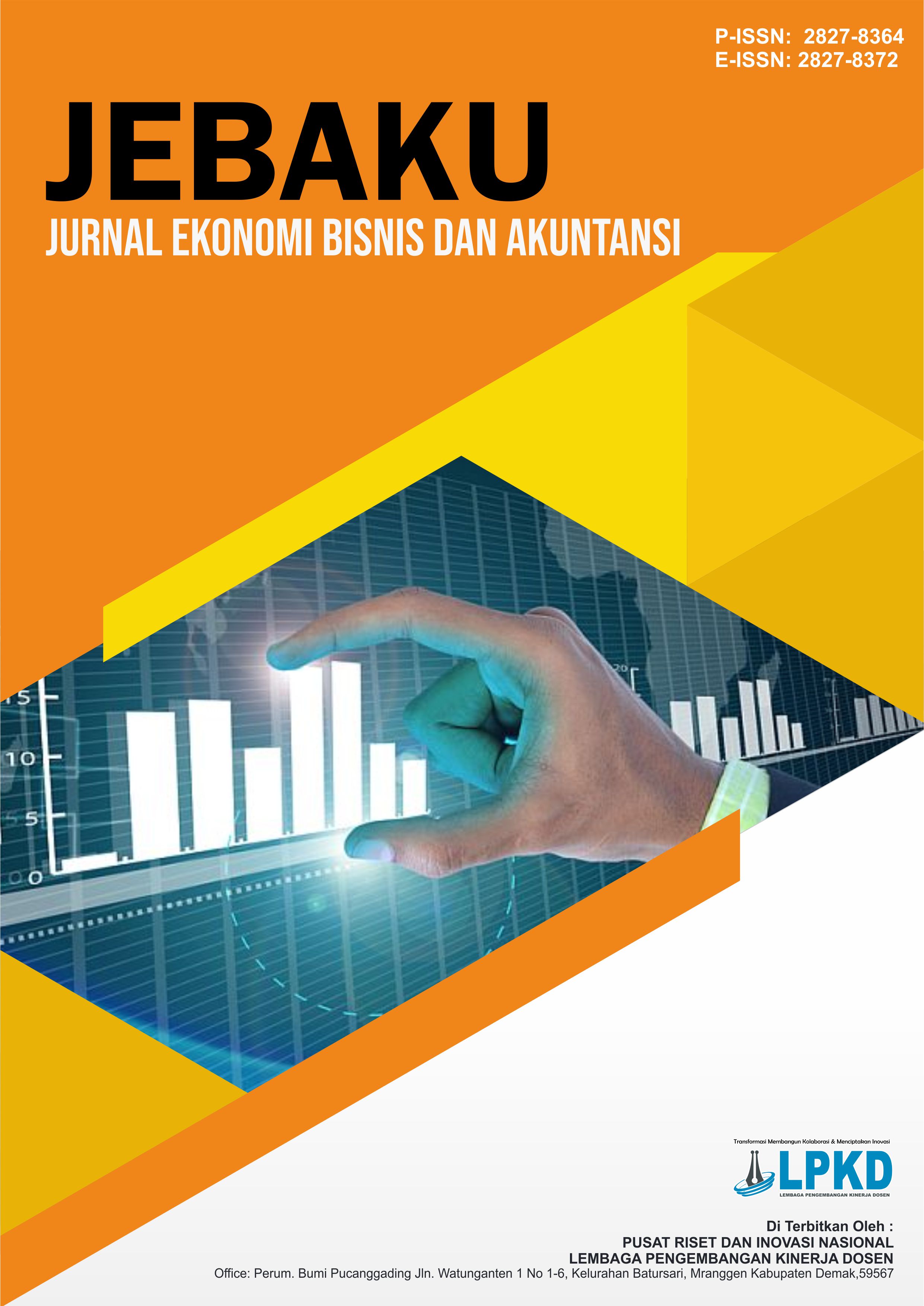Faktor Faktor yang Mempengaruhi Motivasi Pajak Terhadap Kebijakan Transfer Pricing pada Perusahaan yang Terdaftar di Bursa Efek Indonesia
DOI:
https://doi.org/10.55606/jebaku.v2i3.857Keywords:
Key words: Transfer Pricing, Tax Expense, Tax Planning, Leverage and Exchange Rates.Abstract
Transfer pricing is a tool used by companies to control the company's business activities. The purpose of this study was to analyze the factors influencing tax motivation on company policies in conducting transfer pricing. This study uses secondary data obtained from the company's annual audited financial statements, then analyzed using the Statistical Package for Social Sciences (SPSS) program. The results of this study indicate that tax motivational factors are: tax expense, tax planning, leverage and exchange rates that have different influences on the company's transfer pricing policy. Tax expense, tax planning and leverage have a positive influence on company policies in transfer pricing, while exchange rates have a negative influence on the company's policy of transfer pricing.
Downloads
References
DAFTAR PUSTAKA
Amidu, Mohammed, William Coffie & Philomina Acquah 2017, ‘Transfer pricing, earnings management and tax avoidance of firms in Ghana,’ Journal of Financial Crime, vol. 26, no. 2. https://doi.org/10.1108/JFC-10-2017-0091
Armstrong, Christopher S, Stephen Glaeser & John D Kepler 2019, ‘Strategic Reactions in Corporate Tax Planning,‘ Journal of Accounting and Economics, DOI: https://doi.org/10.1016/j.jacceco.2019.03.003.
Bradshaw, Mark, Guanmin Liao & Mark Shuai Ma 2018, ‘Agency costs and tax planning when the government is a major Shareholder,’ Journal of Accounting and Economics,
https://doi.org/10.1016/j.jacceco.2018.10.002.
Borkowski, S.C. (1997), “The transfer pricing concerns of developed and developing countries”, The International Journal of Accounting, Vol. 32 No. 3, pp. 321-336. https://doi.org/10.1016/S0020-7063(97)90014-5
Borkowski, S.C. (2010), “Transfer pricing practices of transnational corporations in PATA countries”, Journal of International Accounting, Auditing and Taxation, Vol. 19 No. 1, pp. 35-54. https://doi.org/10.1016/j.intaccaudtax.2009.12.003
Chan, K.H., Lo, A.W. and Mo, P.L. (2015), “An empirical analysis of the changes in tax audit focus on international transfer pricing”, Journal of International Accounting, Auditing and Taxation, Vol. 24, pp. 94-104. https://doi.org/10.1016/j.intaccaudtax.2014.12.001
Charef, Fahima & Fethi Ayachi 2018, ‘Non-linear causality between exchange rates, inflation, interest rate differential and terms of trade in Tunisia,’ African Journal of Economic and Management Studies, vol. 9, iss 3, pp. 274 – 289. https://doi.org/10.1108/AJEMS-02-2017-0034
Cools, M., Emmanuel, C. and Jorissen, A. (2008), “Management control in the transfer pricing tax compliant multinational enterprise”, Accounting, Organizations and Society, Vol. 33 No. 6, pp. 603-628. https://doi.org/10.1016/j.aos.2007.05.004
Dyreng, S., Lindsey, B.P., Markle, K. and Shackelford, D.A. (2015), “The effect of tax and nontax country characteristics on the global equity supply chains of US multinationals”, Journal of Accounting and Economics, Vol. 59 Nos 2-3, pp. 182-202. https://doi.org/10.1016/j.jacceco.2015.01.003
Ftouhi, Khaoula & Ghardallou, Wafa (2019), International tax planning techniques: a review of the literature, Journal of Applied Accounting Research Vol. 21 No. 2, 2020 pp. 329-343. https://doi.org/10.1108/JAAR-05-2019-0080
Gao, Lu & Xuan Zhao 2015, ‘Determining intra-company transfer pricing for multinational corporations,’ International Journal of Production Economics, vol. 168, pp. 340-350. https://doi.org/10.1016/j.ijpe.2015.07.006
Ghozali, Imam 2018, Aplikasi analisis multivariete dengan program IBM SPSS 25, Semarang: Badan Penerbit Universitas Diponegoro.
Guenther, David A, Steven R Matsunaga & Brian M Williams 2017, ‘Is Tax Avoidance Related to Firm Risk?’ The Accounting Review, vol. 92, no. 1, pp. 115-136. https://doi.org/10.2308/accr-51408
Harahap, Sofyan Syafri 2011, Teori Akuntansi Edisi Revisi, Jakarta: Rajawali Pers.
Holtzman, Yair, Paul Nagel 2014, ‘An introduction to transfer pricing,’ Journal of Management Development, vol. 33, Iss. 1, pp. 57-61. https://doi.org/10.1108/JMD-11-2013-0139
Huizinga, H. and Laeven, L. (2008), “International profit shifting within multinationals: a multi country perspective”, Journal of Public Economic, Vol. 92 No. 5, pp. 1164-1182. https://doi.org/10.1016/j.jpubeco.2007.11.002
Ikatan Akuntansi Indonesia 2015, PSAK No. 7 Tentang Pengungkapan Pihak – Pihak Yang Mempunyai Hubungan Istimewa. Jakarta: IAI.
Kasmir 2018, Analisis Laporan Keuangan Cetakan 11, Jakarta: Rajawali Pers.
Klassen, Kenneth, Petro Lisowsky & Devan Mescall 2013, ‘Transfer pricing: Strategies, practices, and tax minimization,’ Contemporary Accounting Research, vol. 34, no. 1, 2017. https://doi.org/10.1111/1911-3846.12239
Marfuah & Andri Puren Noor Azizah 2014, ‘Pengaruh pajak, tunneling incentive dan exchange rate pada keputusan transfer pricing perusahaan,’ Jurnal Akuntansi dan Auditing Indonesia, vol. 18 no. 2 pp. 156-165. https://doi.org/10.20885/jaai.vol18.iss2.art6
Muhammadi, Abdul Haris, Zahir Ahmed & Ahsan Habib 2016, ‘Multinational transfer pricing of intangible assets: Indonesian tax auditors’ perspectives,’ Asian Review of Accounting, vol. 2, issue. 3, pp. 313-337. https://doi.org/10.1108/ARA-10-2014-0112
Pemerintah Indonesia 2008, Undang-Undang Nomor 36 Tahun 2008 Pasal 18 Tentang Pajak Penghasilan, Lembaran Negara RI Tahun 2008, No. 36, Sekretariat Negara, Jakarta.
Plesner Rossing, C. and Rohde, C. (2010), “Overhead cost allocation changes in a transfer pricing tax compliant multinational enterprise”, Management Accounting Research, Vol. 21 No. 3, pp. 199-216. https://doi.org/10.1016/j.mar.2010.01.002
Pohan, Chairil Anwar 2016, Manajemen perpajakan strategi perencanaan pajak dan bisnis, Jakarta: PT Gramedia Pustaka Utama.
Richardson, Grant, Grantley Taylor & Roman Lanis 2013, ‘Determinant of transfer pricing aggresiveness: Empirical evidence from Australian firms,’ Journal of Contemporary Accounting & Economics, vol. 9, pp. 136 – 150. https://doi.org/10.1016/j.jcae.2013.06.002
.
Sikka, P. and Willmott, H. (2010), “The dark side of transfer pricing: its role in tax avoidance and wealth retentiveness”, Critical Perspectives on Accounting, Vol. 21 No. 4, pp. 342-356. https://doi.org/10.1016/j.cpa.2010.02.004
Taylor, G. and Richardson, G. (2012), “International corporate tax avoidance practices: evidence from Australian firms”, The International Journal of Accounting, Vol. 47 No. 4, pp. 469-496. https://doi.org/10.1016/j.intacc.2012.10.004
Ylönen, M. and Laine, M. (2015), “For logistical reasons only? A case study of tax planning and corporate social responsibility reporting”, Critical Perspectives on Accounting, Vol. 33, December, pp. 5-23 https://doi.org/10.1016/j.cpa.2014.12.001
Wardani, D. K., & Khoiriyah, D. (2018). Pengaruh Strategi Bisnis Dan Karakteristik Perusahaan Terhadap Penghindaran Pajak. Akuntansi Dewantara, 2(1), 25–36.
Watts, Ross L & Jerold L Zimmerman 1978, ‘Towards a Positive Theory of the Determination of Accounting Standards,’ The Accounting Review, vol. 53, no. 1, pp. 112-134. https://www.jstor.org/stable/245729
Watts, Ross L & Jerold L Zimmerman 1986, ‘Positive accounting theory,’ Prentice Hall, New Jersey, United States Of America.
Downloads
Published
How to Cite
Issue
Section
License
Copyright (c) 2022 Jurnal Ekonomi Bisnis dan Akuntansi (JEBAKU)

This work is licensed under a Creative Commons Attribution-ShareAlike 4.0 International License.










